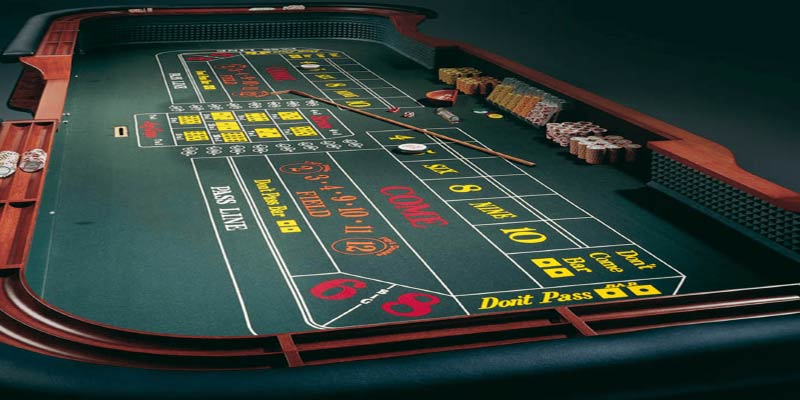
Craps table Layout and Bets
Craps table is an exhilarating setting that attracts players from all walks of life, offering a unique blend of strategy and chance. If you’re looking to dive into the captivating world of craps, understanding its layout and the various bets you can make is essential for success. This guide will equip you with the knowledge needed to navigate any craps table with confidence link new88.
Understanding the Basics of a Craps Table
Before you sit down at a craps table, it’s vital to grasp the basic concepts that govern the game. Unlike many other casino games where you play against the house, in craps, you are betting against other players and the outcome of the dice rolls.
The Objective of Craps
The primary objective in craps is to predict the outcome of the roll of two six-sided dice. Players can bet on various outcomes, including whether the total will be a specific number, whether it will be higher or lower than a certain amount, or if a particular combination of numbers will appear.
Understanding the core objectives of the game is crucial before placing your bets. It empowers players to make informed decisions based on their strategies and risk tolerance.
Types of Craps Tables
When choosing a craps table, you’ll encounter different styles, often distinguishing between “bank craps” and “street craps.”
- Bank Craps: This is the most common version found in casinos and features a well-defined table layout. It has a variety of betting options available.
- Street Craps: Played informally, typically in home settings or back alleys, street craps usually follows simpler rules and doesn’t involve a formal table or dealer.
Knowing the differences allows you to decide which type suits your gaming style best.
Basic Terminology
Familiarizing yourself with the language of craps is essential for effective communication at the table. Here are some terms you’ll commonly encounter:
- Come Out Roll: The first roll of the dice in a betting round.
- Point: If the come-out roll is a 4, 5, 6, 8, 9, or 10, that number becomes the ‘point’ that the player aims to hit again before rolling a 7.
Understanding these terms aids in better comprehension of the game dynamics and enhances your overall gaming experience.
How to Choose the Right Craps Table for Your Casino Night
Selecting the right craps table is crucial to ensuring a fun and engaging experience. With various options available, consider factors such as table limits, atmosphere, and player interactions.
Evaluating Table Limits
Craps tables have minimum and maximum betting limits that can vary significantly from one venue to another. Higher-stakes players may seek tables with more lenient limits, while newcomers might prefer low-limit tables to minimize risks.
Checking the table limits helps set expectations for your gambling session, allowing you to manage your bankroll effectively.
Atmosphere and Crowd
The ambiance of the craps table can greatly influence your enjoyment level. Look for tables that feel inviting and energetic, as this can enhance the overall experience.
A lively crowd can provide excitement and camaraderie, making your time at the table much more enjoyable.
Availability of Players and Dealers
A knowledgeable dealer can clarify rules and assist with betting processes. Additionally, having experienced players at the table can add to your understanding and enjoyment of the game.
Seek out tables that feature friendly dealers and engaging players who are willing to share tips and insights.
The Layout of a Craps Table Explained
The craps table layout can initially seem overwhelming, but understanding its design is essential for effective gameplay. Each section serves a specific purpose, delineating different types of bets.
The Betting Area
The craps table is divided into several sections, with the main betting area being where most action occurs. This section features various betting boxes, each corresponding to different types of bets.
Players place their chips in designated areas for Pass Line, Don’t Pass, Come, and Don’t Come bets. Familiarizing yourself with these areas will enable you to place bets confidently.
The Boxman and Stickman Roles
At a craps table, two key figures help facilitate the game: the Boxman and the Stickman.
- Boxman: Oversees the game, manages the chips, and ensures the proper flow of play.
- Stickman: Responsible for handling the dice and calling the bets made by players.
Understanding these roles enhances your appreciation of the game’s pace and structure, providing insight into how the game operates.
The Dice and Their Importance
Dice play a central role in determining the outcomes in craps. The game mandates using two six-sided dice, and players must ensure they are rolled correctly.
The rules dictate that the dice must hit the back wall of the table, emphasizing the randomness of each roll and the importance of luck in the game.
Common Bets You Can Place at a Craps Table
Understanding the various bets available at the craps table is fundamental to crafting a winning strategy. Each bet carries different risks and rewards, affecting your overall odds of winning.
Pass Line Bet
One of the most popular bets in craps, the Pass Line bet involves wagering that the shooter will roll a 7 or 11 on the come-out roll or that a point will be established and hit again before a 7 is rolled.
This bet is favored by beginners due to its relatively low house edge, making it a great starting point for new players.
Don’t Pass Bet
The Don’t Pass bet is effectively the opposite of the Pass Line bet. By wagering on this option, you’re betting that the shooter will not hit a 7 or 11 on the come-out roll, and instead roll a 2, 3, or 12.
Though less popular among the general public, this bet offers a lower house edge and can be advantageous for skilled players.
Come and Don’t Come Bets
Similar to Pass Line and Don’t Pass bets, the Come and Don’t Come bets are made after a point has been established.
- Come Bet: Similar to Pass Line, betting that the next roll will be a 7 or 11.
- Don’t Come Bet: Opposes the Come bet, wagering that the next roll will be 2, 3, or 12.
These bets offer opportunities for additional winnings during gameplay, adding variety to your betting strategy.
Proposition Bets
Craps table bets are unique wagers made on specific outcomes within a single roll of the dice. These can include betting on specific numbers, combinations, or events happening.
While these bets can offer higher payouts, they also carry a higher house edge, making them riskier choices.




